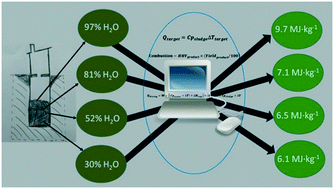Retracted Article: The feasibility of char and bio-oil production from pyrolysis of pit latrine sludge
Abstract
Sustainable methods are required in developing regions to treat and recover value from pit latrine sludge. One potential strategy is to pyrolyse pit latrine contents and generate char and bio-oil, which can then be used as a soil enhancer and fuel, respectively. Despite the many benefits associated with the process, there is very limited relevant literature available. This study examines its feasibility. Initially, the energy balance associated with pyrolysis of sewage sludge was calculated using data from 14 literature studies. For dewatered sewage sludge, the average energy input required during drying and pyrolysis 2.9 ± 0.2 MJ kg−1 sludge, while the average net energy recovered from combustion of bio-oil was 6.9 ± 0.2 MJ kg−1. For sewage sludge which had been dewatered and dried prior to pyrolysis equivalent values were 1.2 ± 0.2 MJ kg−1 and 8.5 ± 0.9 MJ kg−1. Parallel calculations were then undertaken with pit latrine sludge as the hypothetical feedstock, assuming a water content of 30, 52, 82 or 97% wt. The energy input required was 2.1, 2.6, 3.3 and 3.6 MJ kg−1, respectively. Corresponding net energy recoveries from pyrolysis combined with use of the resultant bio-oil as fuel were 9.7 ± 0.8, 7.1 ± 0.8, 6.5 ± 0.8 and 6.1 ± 0.8 MJ kg−1. Char production is more favorable from stabilised pit latrine sludge with lower moisture and volatile solids content. Barriers to pyrolysis of pit latrine sludge are discussed, including the heterogeneity of pit latrine composition and the difficulty of collecting high-viscosity sludge. Overall, this study demonstrates the potential that pyrolysis has as a disposal and value addition method for pit latrine sludge. Innovative methods for sludge drying and pit emptying will expedite the process becoming a reality.



 Please wait while we load your content...
Please wait while we load your content...